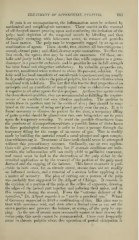Page 895 - My FlipBook
P. 895
TREATMENT OF SUPERFICIAL PULPITIS. 905
If pain is an accompaniment, the inflammation must be reduced by
mechanical and antiphlogistic measures. These consist in the removal
of all decayed matter pressing upon and continuing the irritation of the
pulj) ; local depletion of the congested vessels by bleeding and then
thoroughly syringing with lukewarm water, to remove all particles
of loose matter. The pulp may be temporarily capped by an agent or
combination of agents. These should, first, destroy all bacterial germs
;
second, obtund pain ; and, third, destroy septic emanations. To effect the
first result, the agents that may be used are numerous. Of these, car-
bolic acid justly holds a liigh place ; but this, while superior as a germ-
destroyer, is a powerful escharotic, and in practice its use in full strength
has been found not altogether satisfactory. Its valuable properties are,
however, manifested when reduced to about 20-per-cent. solution. C^ar-
bolic acid is a local anaesthetic of considerable importance and can usually
be depended upon to relieve the pain of pulpitis, but is more effective when
combined with iodoform. The fact that this has the dual properties of an
antiseptic and an anaesthetic of nearly equal value to chloroform renders
it superior to all other agents for this purpose. As these two agents cover
the three desired qualities, they are recommended as fulfilling the require-
ments of an excellent and very effective application. The medium to
retain these in position may be the oxide of zinc ; they should be com-
bined at the moment of using and placed gently over the pulp. If it is
found necessary to dismiss the patient for the time, a temporary filling
of gutta-percha should be placed over this, care being taken not to press
upon the temporary covering. To avoid the possible disturbance from
the products of decomposition—ahvays a possible factor of disturbance
in these pathological states—it is safer to leave a passage through the
temporary filling for the escape of an excess of gas. This is readily
made by building the material round a canal-plugger and upon comple-
tion withdrawing it. Treatment of these teeth should never be attempted
without this precautionary measure. Ordinarily, one or two applica-
tions will give satisfactory results ; but if systemic conditions are unfa-
vorable, the inflammation will not easily yield to palliative treatment,
and resort must be had to the destruction of the pulp either by the
arsenical application or by the removal of the portion of the pulp most
diseased and the capping of the balance. This latter treatment is pref-
erable in both cases, for, as already stated, arsenic does not act readily
on inflamed surfaces, and a removal of a section before applying it is
a matter of necessity. The plan of cutting out a portion of the pulp
was probably first suggested by Dr. Allport of Chicago. It consists in
the excision of a portion of the pulp at the orifice of exposure, drawing
the edges of the incised part together and inducing their union, and in
this manner closing the wound. From the " extreme delicacy of the
operation," Dr. Allport regards it as '' rarely a practical one." Witzel
of Germany suggested in 1879 a modification of this. His plan was to
treat with arsenious acid, and then after a limited time to cut out the
crown portion and preserve the balance, or stump, of the pulp by cap-
ping. As the use of arsenic must necessarily sooner or later destroy the
entire pulj), this mode cannot be recommended. Cases very frequently
occur in chronic pulpitis where this operation of partial extirpation is


